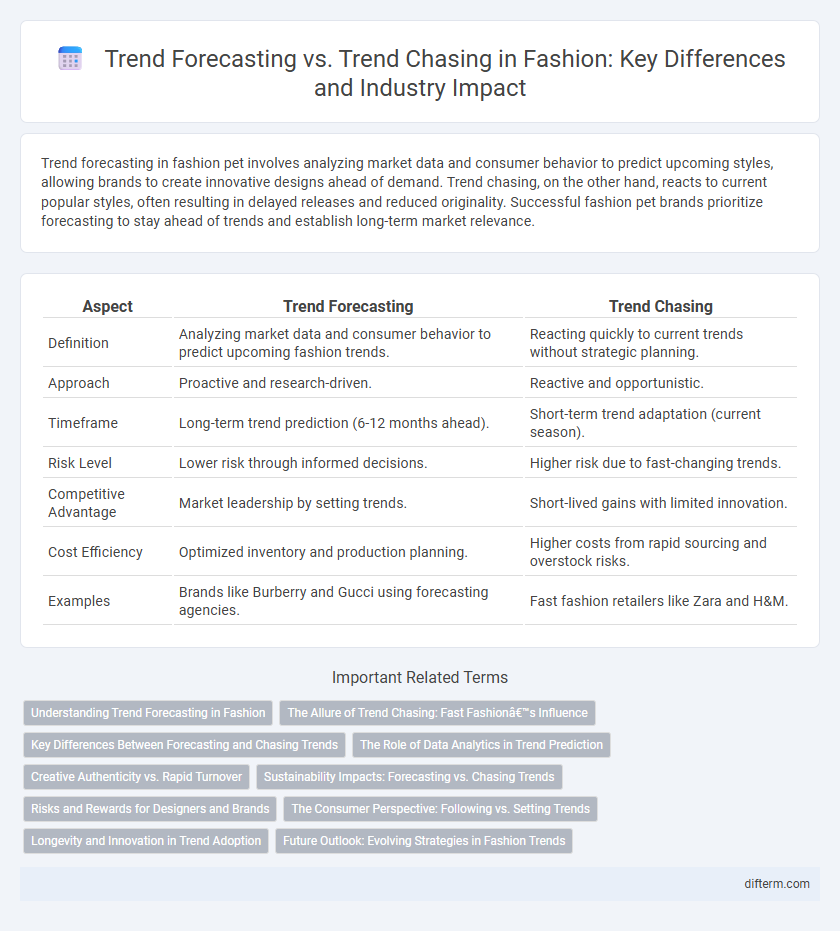Trend forecasting in fashion pet involves analyzing market data and consumer behavior to predict upcoming styles, allowing brands to create innovative designs ahead of demand. Trend chasing, on the other hand, reacts to current popular styles, often resulting in delayed releases and reduced originality. Successful fashion pet brands prioritize forecasting to stay ahead of trends and establish long-term market relevance.
Table of Comparison
| Aspect | Trend Forecasting | Trend Chasing |
|---|---|---|
| Definition | Analyzing market data and consumer behavior to predict upcoming fashion trends. | Reacting quickly to current trends without strategic planning. |
| Approach | Proactive and research-driven. | Reactive and opportunistic. |
| Timeframe | Long-term trend prediction (6-12 months ahead). | Short-term trend adaptation (current season). |
| Risk Level | Lower risk through informed decisions. | Higher risk due to fast-changing trends. |
| Competitive Advantage | Market leadership by setting trends. | Short-lived gains with limited innovation. |
| Cost Efficiency | Optimized inventory and production planning. | Higher costs from rapid sourcing and overstock risks. |
| Examples | Brands like Burberry and Gucci using forecasting agencies. | Fast fashion retailers like Zara and H&M. |
Understanding Trend Forecasting in Fashion
Trend forecasting in fashion involves analyzing consumer behavior, cultural shifts, and market data to predict upcoming styles and preferences months or even years in advance. Unlike trend chasing, which reacts to immediate popular trends, forecasting provides designers and brands with strategic insights to create collections that resonate with future demands. Accurate trend forecasting enhances sustainability by reducing overproduction and aligning products with genuine consumer needs.
The Allure of Trend Chasing: Fast Fashion’s Influence
Trend chasing in fast fashion captures consumer desire for immediacy by rapidly transforming runway styles into affordable, accessible garments. This responsiveness drives high sales volumes but often sacrifices sustainability and long-term brand identity. Emphasizing trend forecasting instead enables brands to anticipate shifts, fostering innovation and more responsible production cycles.
Key Differences Between Forecasting and Chasing Trends
Trend forecasting involves systematic analysis of cultural, social, and economic data to predict fashion directions months or years ahead, while trend chasing reacts to emerging styles after they gain popularity. Forecasting empowers brands with strategic planning and innovation, enabling proactive design and market positioning. Chasing trends often leads to short-lived, derivative products lacking originality and long-term brand value.
The Role of Data Analytics in Trend Prediction
Data analytics plays a crucial role in trend prediction by analyzing comprehensive consumer behavior, social media patterns, and market data to identify emerging fashion trends before they peak. This proactive approach enables brands to create innovative designs and strategic marketing plans, avoiding the pitfalls of trend chasing which often leads to reactive and short-lived product launches. Leveraging big data and AI-driven insights empowers fashion companies to maintain a competitive edge through accurate and timely trend forecasting.
Creative Authenticity vs. Rapid Turnover
Trend forecasting emphasizes creative authenticity by anticipating consumer desires and fostering innovative designs that endure beyond seasonal fads. In contrast, trend chasing prioritizes rapid turnover, quickly replicating popular styles to capitalize on immediate market demand but often sacrifices originality. Designers committed to forecasting build lasting brand identity, while fast-fashion brands focus on speed and volume to stay relevant.
Sustainability Impacts: Forecasting vs. Chasing Trends
Trend forecasting in fashion enables brands to anticipate consumer preferences and design sustainable collections, reducing waste and overproduction significantly. In contrast, trend chasing often leads to rapid cycles of disposable clothing, exacerbating environmental damage through increased resource consumption and textile waste. Prioritizing forecasting supports long-term sustainability goals by fostering mindful production that aligns with predicted market demands.
Risks and Rewards for Designers and Brands
Trend forecasting enables designers and brands to anticipate market demands, reducing production risks and enhancing strategic planning for sustainable growth. Trend chasing, while offering quick capital gains, often leads to inventory overstock, brand dilution, and short-lived consumer engagement. Balancing forecasting and chasing optimizes innovation and market relevance, ultimately strengthening competitive advantage in the dynamic fashion industry.
The Consumer Perspective: Following vs. Setting Trends
Consumers who engage in trend forecasting anticipate fashion shifts by analyzing market data and cultural cues, enabling them to adopt styles ahead of the mainstream. In contrast, trend chasers reactively follow popular trends after they have gained widespread visibility, often resulting in delayed adoption and less originality. Brands that empower consumers to become trendsetters foster deeper loyalty by aligning products with emerging desires before they become saturated.
Longevity and Innovation in Trend Adoption
Trend forecasting emphasizes longevity by analyzing consumer behavior, cultural shifts, and technological advancements to anticipate fashion movements before they emerge. In contrast, trend chasing focuses on immediate popularity, often leading to short-lived adoption and rapid obsolescence. Sustainable innovation in trend forecasting drives preemptive design strategies that support enduring market relevance and reduced waste.
Future Outlook: Evolving Strategies in Fashion Trends
Fashion trend forecasting leverages data analytics, consumer behavior insights, and cultural signals to predict emerging styles months in advance, enabling brands to innovate strategically. In contrast, trend chasing relies on rapid replication of fleeting fads, often leading to unsustainable practices and missed opportunities for brand differentiation. Future outlooks emphasize integrating AI-driven forecasting tools and sustainable methodologies, positioning proactive trend anticipation as essential for long-term market relevance and competitive advantage.
trend forecasting vs trend chasing Infographic

 difterm.com
difterm.com